For the 2025 school year, there are 8 public elementary schools serving 1,743 students in Uniontown Area School District. This district's average elementary testing ranking is 4/10, which is in the bottom 50% of public elementary schools in Pennsylvania.
Public Elementary Schools in Uniontown Area School District have an average math proficiency score of 25% (versus the Pennsylvania public elementary school average of 35%), and reading proficiency score of 50% (versus the 54% statewide average).
Minority enrollment is 28% of the student body (majority Black), which is less than the Pennsylvania public elementary school average of 42% (majority Hispanic and Black).
Overview
This School District
This State (PA)
# Schools
9 Schools
2,145 Schools
# Students
2,449 Students
1,108,977 Students
# Teachers
185 Teachers
82,943 Teachers
Student : Teacher Ratio
13:1
13:1
District Rank
Uniontown Area School District, which is ranked within the bottom 50% of all 675 school districts in Pennsylvania (based off of combined math and reading proficiency testing data) for the 2021-2022 school year.
The school district's graduation rate of 70-74% has decreased from 75% over five school years.
Overall District Rank
#439 out of 684 school districts
(Bottom 50%)
(Bottom 50%)
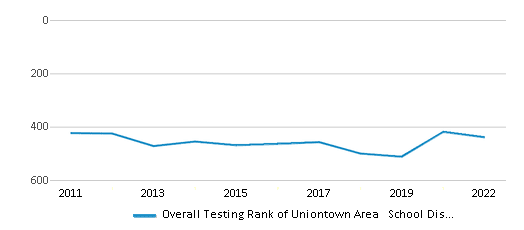
Math Test Scores (% Proficient)
27%
36%
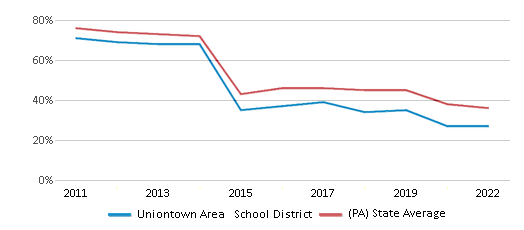
Reading/Language Arts Test Scores (% Proficient)
52%
55%

Science Test Scores (% Proficient)
50%
57%
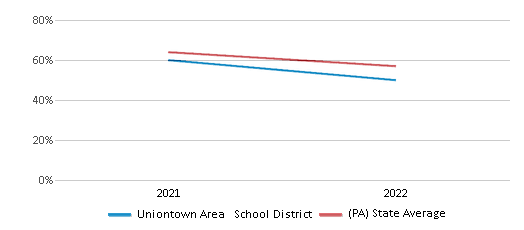
Graduation Rate
70-74%
87%
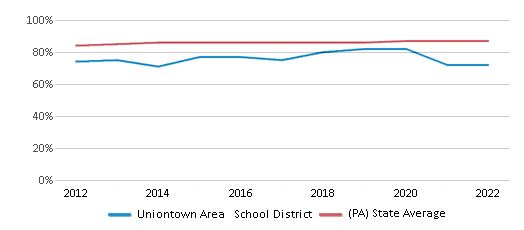
Students by Ethnicity:
Diversity Score
0.45
0.61
# American Indian Students
1 Student
2,278 Students
% American Indian Students
n/a
n/a
# Asian Students
15 Students
51,838 Students
% Asian Students
1%
5%
# Hispanic Students
83 Students
173,776 Students
% Hispanic Students
3%
16%
# Black Students
354 Students
169,696 Students
% Black Students
14%
15%
# White Students
1,777 Students
645,871 Students
% White Students
73%
58%
# Hawaiian Students
25 Students
965 Students
% Hawaiian Students
1%
n/a
# Two or more races Students
194 Students
63,991 Students
% of Two or more races Students
8%
6%
Students by Grade:
# Students in PK Grade:
-
7,744
# Students in K Grade:
198
110,287
# Students in 1st Grade:
207
120,767
# Students in 2nd Grade:
208
126,133
# Students in 3rd Grade:
187
120,907
# Students in 4th Grade:
199
125,574
# Students in 5th Grade:
179
126,000
# Students in 6th Grade:
181
126,698
# Students in 7th Grade:
214
94,854
# Students in 8th Grade:
170
93,972
# Students in 9th Grade:
241
16,255
# Students in 10th Grade:
184
14,467
# Students in 11th Grade:
138
12,872
# Students in 12th Grade:
143
12,447
# Ungraded Students:
-
-
District Revenue and Spending
The revenue/student of $21,135 in this school district is less than the state median of $23,696. The school district revenue/student has stayed relatively flat over four school years.
The school district's spending/student of $20,290 is less than the state median of $23,119. The school district spending/student has stayed relatively flat over four school years.
Total Revenue
$52 MM
$39,541 MM
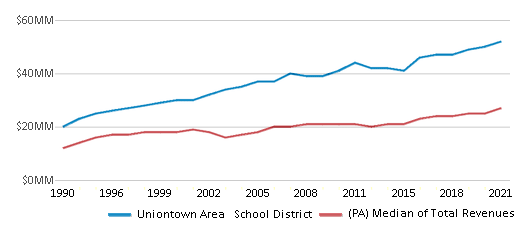
Spending
$50 MM
$38,578 MM
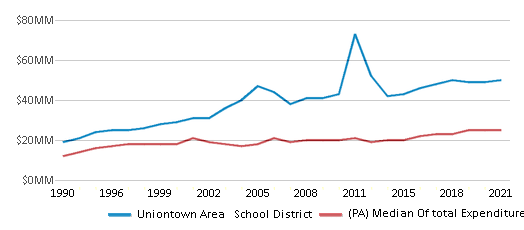
Revenue / Student
$21,135
$23,696
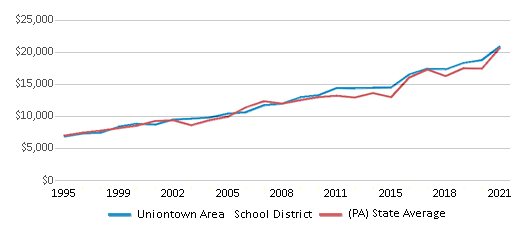
Spending / Student
$20,290
$23,119
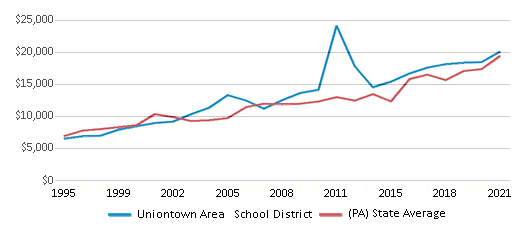
Best Uniontown Area School District Public Elementary Schools (2025)
School
(Math and Reading Proficiency)
(Math and Reading Proficiency)
Location
Grades
Students
Rank: #1 - 21. - 2.
Menallen School
(Math: 40-44% | Reading: 60-64%)
Rank:
Rank:
6/
Top 50%10
8 Pedro Drive
Uniontown, PA 15401
(724) 438-4160
Uniontown, PA 15401
(724) 438-4160
Grades: K-6
| 317 students
Rank: #1 - 21. - 2.
Wharton School
(Math: 40-44% | Reading: 60-64%)
Rank:
Rank:
6/
Top 50%10
136 Elliotsville Road
Farmington, PA 15437
(724) 329-5510
Farmington, PA 15437
(724) 329-5510
Grades: K-5
| 148 students
Rank: #33.
Franklin School
(Math: 35-39% | Reading: 60-64%)
Rank:
Rank:
6/
Top 50%10
242 Buena Vista Road
Vanderbilt, PA 15486
(724) 628-6030
Vanderbilt, PA 15486
(724) 628-6030
Grades: K-6
| 130 students
Rank: #44.
Marclay School
(Math: 30-39% | Reading: 60-69%)
Rank:
Rank:
6/
Top 50%10
111 Bruceton Road
Markleysburg, PA 15459
(724) 329-4248
Markleysburg, PA 15459
(724) 329-4248
Grades: K-5
| 89 students
Rank: #55.
A J Mcmullen School
(Math: 15-19% | Reading: 55-59%)
Rank:
Rank:
4/
Bottom 50%10
4773 National Pike
Markleysburg, PA 15459
(724) 329-8811
Markleysburg, PA 15459
(724) 329-8811
Grades: 6-8
| 162 students
Rank: #66.
Ben Franklin School
(Math: 22% | Reading: 49%)
Rank:
Rank:
3/
Bottom 50%10
351 Morgantown St
Uniontown, PA 15401
(724) 439-5020
Uniontown, PA 15401
(724) 439-5020
Grades: K-8
| 486 students
Rank: #77.
Lafayette Middle School
(Math: 6-9% | Reading: 30-34%)
Rank:
Rank:
2/
Bottom 50%10
303 Connellsville St
Uniontown, PA 15401
(724) 438-3581
Uniontown, PA 15401
(724) 438-3581
Grades: 6-8
| 144 students
Rank: #88.
Lafayette Elementary School
(Math: 10-14% | Reading: 20-24%)
Rank:
Rank:
2/
Bottom 50%10
303 Connellsville St
Uniontown, PA 15401
(724) 438-3581
Uniontown, PA 15401
(724) 438-3581
Grades: K-5
| 267 students
Recent Articles

What Is A Charter School?
Explore the world of charter schools in this comprehensive guide. Learn about their history, how they operate, and the pros and cons of this educational innovation. Discover key facts about charter schools, including admission policies, demographics, and funding, as well as what to look for when considering a charter school for your child.

10 Reasons Why High School Sports Benefit Students
Discover the 10 compelling reasons why high school sports are beneficial for students. This comprehensive article explores how athletics enhance academic performance, foster personal growth, and develop crucial life skills. From improved fitness and time management to leadership development and community representation, learn why participating in high school sports can be a game-changer for students' overall success and well-being.

February 05, 2025
Understanding the U.S. Department of Education: Structure, Impact, and EvolutionWe explore how the Department of Education shapes American education, from its cabinet-level leadership to its impact on millions of students, written for general audiences seeking clarity on this vital institution.





